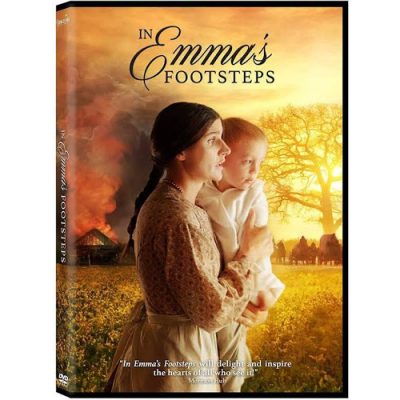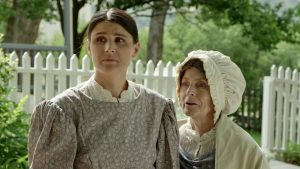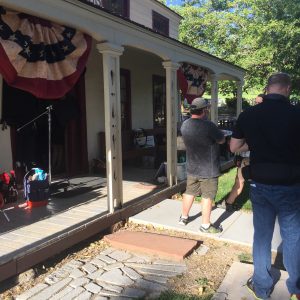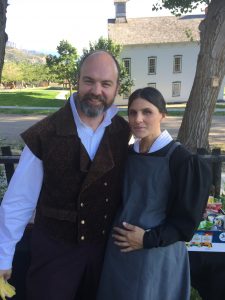
 SALT LAKE CITY — Shona Kay Moyer was “terrified” to portray Emma Smith in the upcoming film “In Emma’s Footsteps.”
SALT LAKE CITY — Shona Kay Moyer was “terrified” to portray Emma Smith in the upcoming film “In Emma’s Footsteps.”
After the 1844 martyrdom of Joseph Smith, founder of The Church of Jesus Christ of Latter-day Saints, members of the church followed his successor, Brigham Young, out west. Joseph’s wife, Emma Smith, chose to stay behind with her family and Lucy Mack Smith, Joseph’s mother. This choice led to a rift between Emma and Brigham Young, which lead to decades of misconceptions about Emma Smith.
The movie “In Emma’s Footsteps” is a non-linear look at Emma’s life after Joseph’s death. It opens June 1 and will play in Utah Megaplex theaters.
Moyer is a British-born actress who currently resides in Utah. While filming “In Emma’s Footsteps” she was also working on the LDS Church’s Book of Mormon video project. Her most recent film was “Love, Kennedy.”
Moyer’s fear of playing Emma came from three places: first, the pressure of playing a well-known historical character; second, learning to speak in an “old-timey United States New England accent;” and third — learning to portray Emma, a woman she saw as a “spiritual wonder” and “mystery.”
“I really felt that I had to focus on giving her a voice that would really unveil her humanity, and maybe try and help people connect with her on an emotional level,” Moyer told the Deseret News.
Within hours of her audition, Producer Brian Brough and Scriptwriter/Director Brittany Wiscombe informed Moyer she had the part — and that filming began in three days.
“I just basically prayed the whole way through it,” Moyer said with a laugh.
Filming ran for two weeks, and then another challenge popped up: The project ran out of funding. Filming stopped and it was unknown when or if it would start again. That delay ended up lasting five years.
In between other filming projects, Brough would return to the idea of the Emma Smith movie, but it was never the right time.
 Meanwhile, Moyer gave birth to two of her three children, all while wondering if the film would ever be picked up again. But her preparation for the role continued unintentionally. Moyer was asked to speak at various church functions as Emma Smith, which prompted her to continue learning about Emma. Later, she was even called upon to portray Emma Smith in videos featured in The Church of Jesus Christ of Latter-day Saints’ new Church History Museum display.
Meanwhile, Moyer gave birth to two of her three children, all while wondering if the film would ever be picked up again. But her preparation for the role continued unintentionally. Moyer was asked to speak at various church functions as Emma Smith, which prompted her to continue learning about Emma. Later, she was even called upon to portray Emma Smith in videos featured in The Church of Jesus Christ of Latter-day Saints’ new Church History Museum display.
Moyer struggled to understand why she continued to be thrown into this specific role.
“‘What am I not learning?’ is really what I thought,” Moyer said. “‘What am I not getting here, because I know I’m not the brightest but I’m not that thick!’”
In the midst of her frustration, her husband offered up an alternative reason.
“Maybe it’s not something you’re supposed to learn,” he told her, “maybe it’s something you’re supposed to do.”
So, five years after filming had begun and ended, Moyer sat down and wrote what she called a “massive letter” to Brough.
In her letter, Moyer told Brough she felt an “absolute desire” to do whatever she could to finish the project and tell Emma’s story.
To her surprise, Brough responded, “Let’s do it.”
He explained the film would be a scaled-back version of their original plan, and that they didn’t have the money they were planning on, but they at least had the script. Filming began a few months later. All the pieces had fallen into place.
Once filming began, Brough and Wiscombe said they didn’t face any major hiccups or problems, which Wiscombe said she took as “a wonderful blessing.” For Moyer, however, filming presented personal challenges she had to work to overcome.
“I have always felt this, almost a burden of responsibility, when portraying Emma, to be worthy of doing so,” Moyer said, explaining that before she was cast, she hadn’t attended an LDS temple in a while, but after receiving the role, she felt compelled to do so.
“It actually changed my life quite a lot,” Moyer said.
“When you try to emulate somebody who is so faithful, and somebody who is so good, like she was … I wanted to become more like her,” she continued. “I felt myself really taking on that challenge and really trying to be more like her.”
Of course, portraying Emma also meant acting out some of Emma’s greatest traumas and trials. Moyer described Emma’s circumstances as nearly impossible to withstand and referred to a famous quote from Lucy Mack Smith, in which she said the trials Emma withstood “would have borne down almost any other woman.”
After filming for 12 hours in one day, Moyer said she would return home and collapse, feeling emotionally drained, wondering how she could do it again the following day.
 But Moyer believe she had heavenly help in portraying Emma. During filming, she had several profound experiences. Moyer said she would prepare to film a scene, and feel like she knew what emotions she wanted to portray. As soon as filming began, however, “this feeling would come over me and it would not be my own feelings, it would not be my own emotions.”
But Moyer believe she had heavenly help in portraying Emma. During filming, she had several profound experiences. Moyer said she would prepare to film a scene, and feel like she knew what emotions she wanted to portray. As soon as filming began, however, “this feeling would come over me and it would not be my own feelings, it would not be my own emotions.”
Moyer firmly believes her heavenly help came from Emma Smith herself.
She said she believes Emma wants her story to be told. Brough and Wiscombe both added they feel it’s important for people to see the film to gain a better understanding, and perhaps a little more sympathy, toward Emma, who is sometimes criticized in LDS circles for not joining other church members during the church’s exodus to Utah.
“We don’t want to try to be definitive on ‘this is why she did things,’ because the reality is, most people don’t (know),” Brough said. “We want people to be able to put themselves in her shoes and say, ‘Had I been there … would I have done what she did, or something else?’”
Brough said the film tries to address things like the feud between Brigham Young and Emma Smith and “paint it in as neutral a light as possible” so people can make up their own minds.
“Our focus it really to give her that voice and to unveil her humanity, and to unveil that she was flawed, yeah, but also complex and beautifully human,” Moyer said. “And I think that is something that people can connect with, because God doesn’t only use perfect people in his work, otherwise we’d all be kind of out of luck.”
